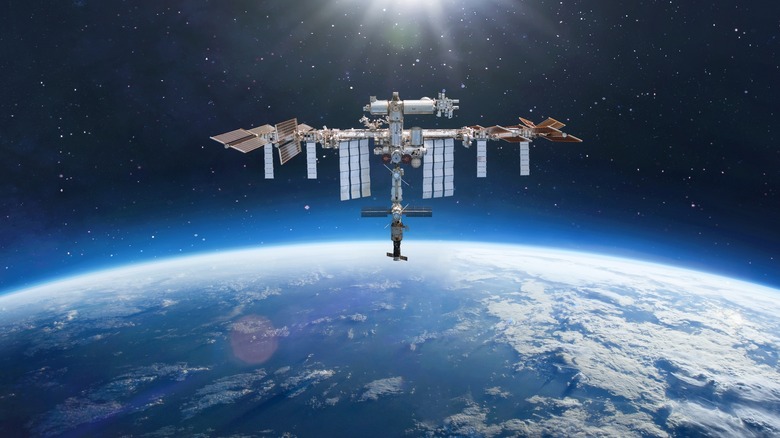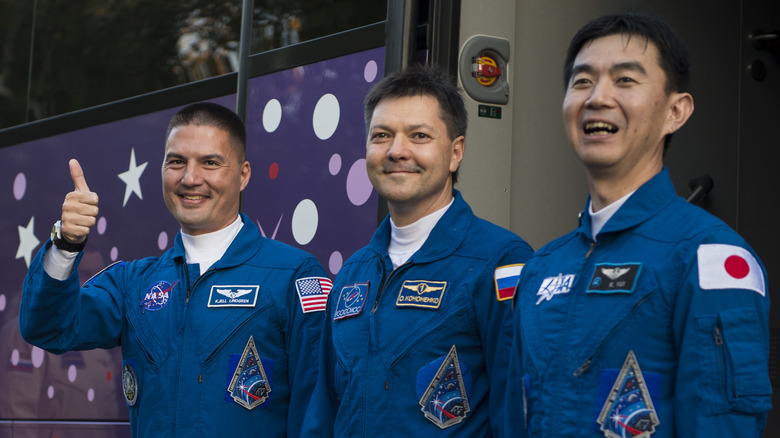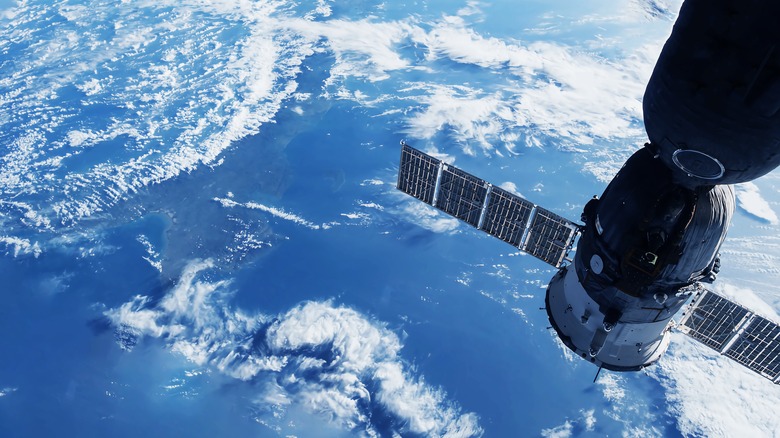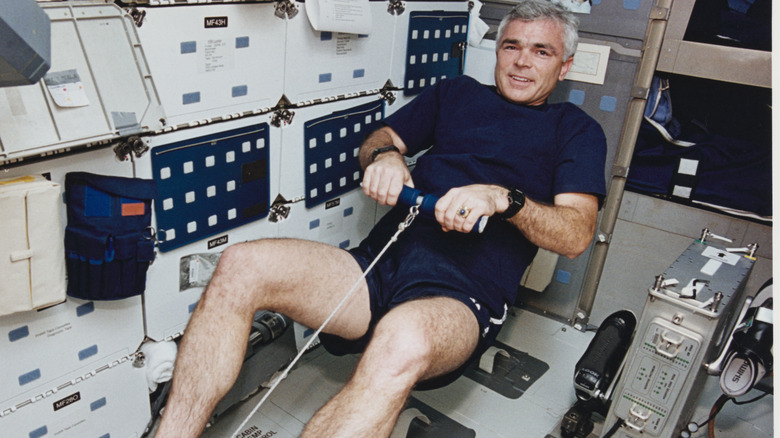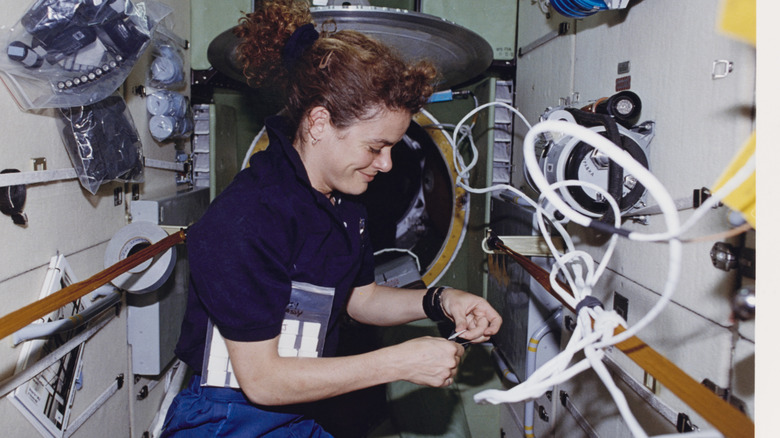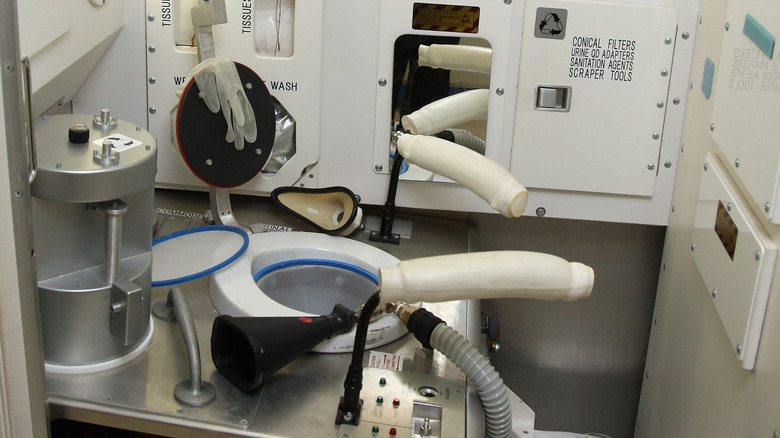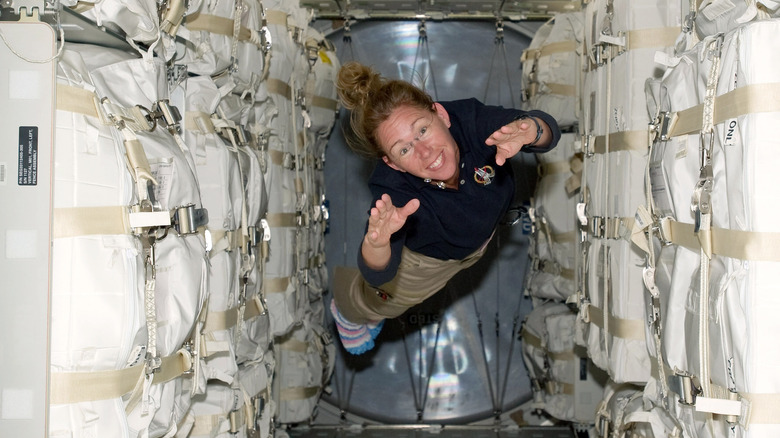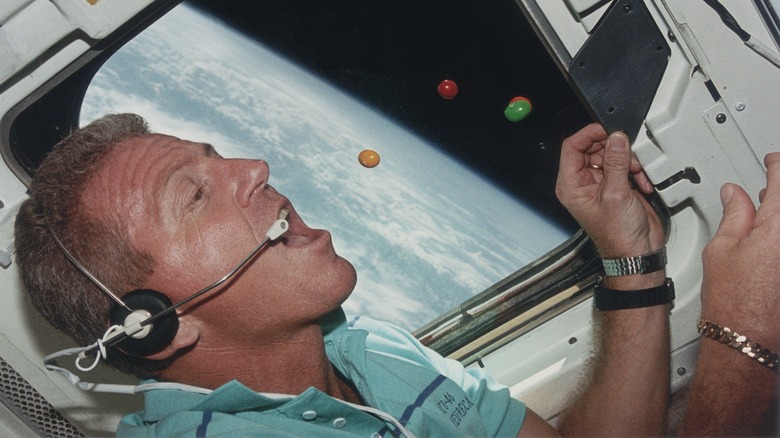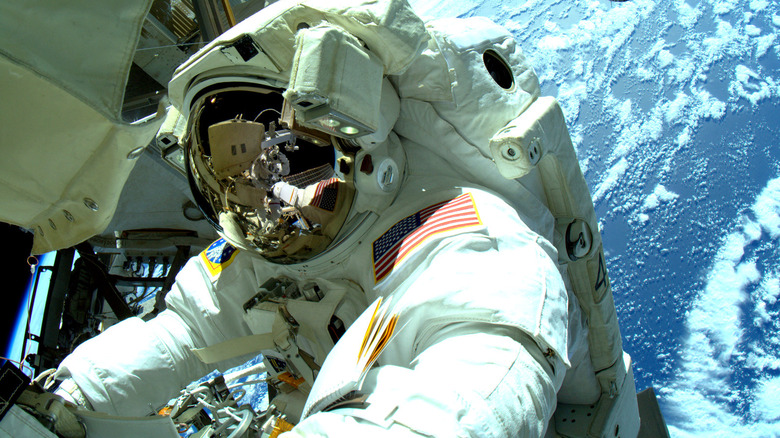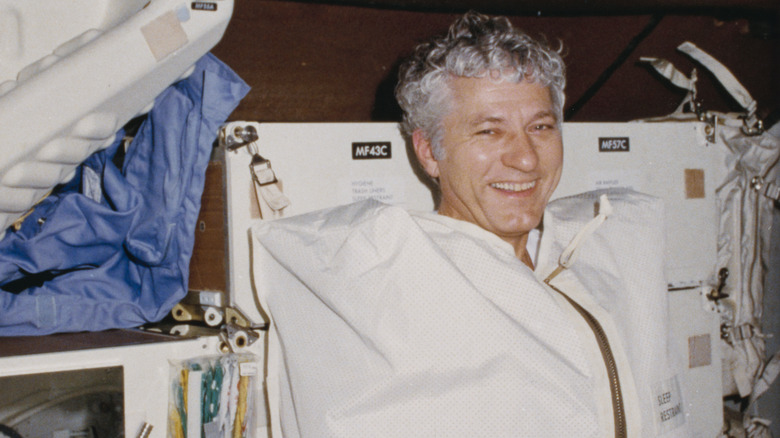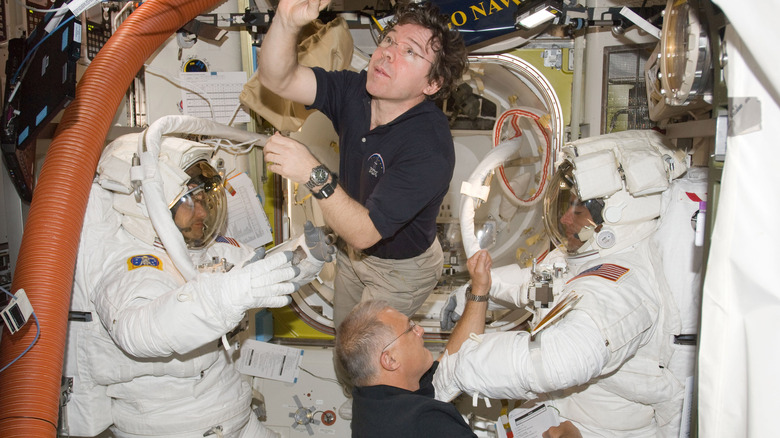10 Things About Living On The International Space Station You Probably Never Realized
The International Space Station is a technological marvel and an incredible feat of engineering. Construction began on the ISS in the early 1990s, with cooperation between several nations and space agencies required to complete it before its launch in 1998. Now the largest space station to have ever been designed and built, the ISS is used to carry out research and experiments that would be impossible on Earth, and is constantly being upgraded with new parts.
Running the ISS is a crew that can number up to seven individuals. These astronauts and cosmonauts spend months in space and have to go through extensive training to make sure they will be able to withstand the unique environmental pressures that come with living on the ISS. That's because everyday tasks and bodily functions that require little thought on Earth can suddenly become very difficult in microgravity.
Living on the ISS is much harder than you might have realized, given that the crew has to put up with all of these different factors as part of their daily life.
There are a lot of different nationalities onboard
The very name of the International Space Station suggests that it is a worldwide endeavor, rather than something under the control of a single country. While NASA of the United States and Russia's Roscosmos are most closely associated with the ISS, a number of other nations were also involved in the design of the facility, and continue to help with its operation through a series of partnerships and agreements — something that is necessary considering the huge cost of the project, which is estimated to be more than $100 billion.
JAXA of Japan, the European Space Agency, and the Canadian Space Agency have all contributed, with countries such as Italy, Germany, France, Spain, and the United Kingdom all involved. Brazil was also a partner between 1997 and 2007, and there have been discussions about other nations, such as China, also joining.
Approximately 270 people have visited the ISS from some 21 countries. While US astronauts are by far the most frequent, it means that anyone going to the ISS will almost certainly have to work with people from other nationalities while aboard. Due to this, those going to the ISS will usually speak more than one language, and some basic knowledge of Russian and English is necessary as both NASA and Roscosmos are in charge of various procedures on the station, and communication is key for safety and effectiveness.
Astronauts can spend a very long time on the station
Going up to the ISS is no minor thing. It requires a huge commitment from the crew, as they'll undoubtedly be onboard the station for a significant period of time. Following the discontinuation of the Space Shuttle, NASA has had to send its astronauts to the ISS via Soyuz spacecraft from Russian territory at an ever-pricier cost. Estimates suggest that NASA is charged in the region of $86 million per astronaut. While that figure will likely come down when Boeing and SpaceX start to transport cargo and crew to the ISS from U.S. soil, it is still prohibitively expensive to rotate the people on the station frequently.
What that means for the crew of the ISS is that they will have to stay on the station for a long time before another shuttle is able to bring them home. According to the Kennedy Space Center, the average mission length for astronauts going to the ISS is around six months. With the station orbiting Earth 16 times a day, the crew will go around the planet thousands of times during their mission.
Some astronauts will spend a lot more time on the ISS. Scott Kelly "spent 340 days, almost a full year, on the facility. Meanwhile, both Frank Rubio and Mark Vande Hei have had longer missions, staying on the ISS for 371 and 355 days, respectively. Peggy Whitson has the current U.S. record for total cumulative time on the ISS, spending 655 days on it across multiple missions.
There's a gym and astronauts have to work out every day
Visiting the ISS is not like going on vacation: Astronauts are expected to do a lot of exercise while in space. There are a number of reasons why residents of the ISS have to stay in shape, chief among them being it will keep everyone onboard as fit and healthy as possible — something that is especially important considering the lack of medical supplies and doctors on the station. That's why NASA and other space agencies put candidates through such a vigorous testing regimen, to help lower the odds of any medical emergencies taking place on the ISS. It's also why the crew have medical training to perform basic first aid and procedures.
However, space also poses a number of unique challenges for the human body. The lack of gravity leads to bone and muscle loss, as the body no longer has to work so hard against gravity. This means that the crew has to maintain their bones and muscles with a workout program designed to make sure they don't suffer from atrophy. It isn't uncommon for astronauts to spend more than two and a half hours exercising in the ISS gym, six days out of seven. The facility is stocked with an exercise bike, a treadmill, and an Advanced Resistive Exercise Device — essentially a weightlifting machine — that have all been adapted for use in the station's low-gravity environment, with straps to hold the crew in place while they get their pump on.
The station is big but incredibly cramped
From the outside, the ISS is a huge structure. In fact, the station is so massive that it can actually be seen with the naked eye from Earth when it passes overhead. According to NASA, the ISS is 357 feet long from one end to the other, which is only a few feet smaller than a standard football field. With a livable surface area of over 5,000 square feet, the ISS is comparable to a large six-bedroom house. It also comes equipped with seven sleeping quarters and two bathrooms.
If that makes the ISS sound roomy, think again. The total living space available, once you take into account all of the room for equipment and storage, is just a little over 10,000 cubic feet. Almost every single location where the crew spends their time is cramped — no place for someone who suffers from claustrophobia.
A video posted online by Russian cosmonaut Oleg Artemyev gives a good idea of what it is like to live on the ISS and travel around its cramped interior. The footage shows how difficult it can be to move around the small spaces, with the crew often having to crawl or maneuver through tiny holes.
Going to the toilet is a complicated task
Even the most mundane tasks become complicated on the ISS. Most people don't think too much about going to the toilet back home. After all, it is a relatively easy process for most people, requiring just a simple lift of the toilet seat or for a person to sit down and drop their trousers. The environmental conditions on the ISS make this more difficult. In particular, the microgravity prevents a normal toilet from being effective, as individuals cannot rely on waste simply dropping into the bowl.
Without gravity to assist, urine, feces, and other waste material could easily float around and cause havoc. No one wants to come into contact with human waste, and the waste could also damage sensitive equipment. So it's clearly a major problem and one that has been hard to fully overcome. Nowadays, crew on the ISS use a sophisticated vacuum toilet that NASA designed at the cost of some $23 million and is much easier to use, by both male and female astronauts, than previous models.
This toilet features two different parts, depending on the needs of the moment. A funneled hose that is held tight to the skin is used for urination, sucking up all the liquid as it passes out of the body. Unlike previous toilets, the crew can use this hose while standing or sitting so they are more comfortable. Defecation requires the person in question to sit on a small seat that creates a seal to the skin, with the toilet immediately activating suction to pull away waste and prevent any smells from spreading. Wipes and paper are then disposed of in special bins, along with the gloves that astronauts wear throughout the process.
Astronauts are constantly drinking recycled pee
Sending anything at all to the ISS is an expensive endeavor. The heavier a spacecraft is, the more fuel it will need to reach the station, vastly increasing the cost. To put this into perspective, NASA signed contracts with SpaceX and Orbital Science to deliver cargo to the ISS that were each in excess of $1 billion. When calculating the price per pound to take goods and equipment to the station, a bottle of water could easily cost more than $10,000. Considering this expense, it makes a lot of sense that NASA and other space agencies would want to recycle as much water as possible, so they can either save money or use the space for other cargo.
While the Russian crew on the ISS don't recycle their pee, the U.S. side does just that. In fact, NASA and allied astronauts recycle up to 98% of the water content of urine, separating out the water from the other waste products. This helps them to recover 6,000 liters of water every year through the Environmental Control and Life Support System. This uses a vacuum system to extract water not only from pee but also water from the air and the sweat of crew members through dehumidifiers.
Iodine is added to the filtered water, which is purified more than standard drinking water on Earth so that the crew can safely drink it. Astronauts on the ISS have confirmed that it tastes no different from bottled water, and that it simply takes some time to get used to the fact that the water has been reclaimed from urine and other sources.
Food has to be carefully prepared and can taste different in space
Outside of drinking and using the bathroom, another key element that is essential for the crew to remain healthy on the ISS is the food they eat. The microgravity environment on the station can make consuming meals challenging. Any crumbs could easily float away and create an unhealthy living space or even damage highly sensitive equipment. Certain foods, such as bread, are banned completely as they produce too many crumbs and require a special preparation method, as meals are generally freeze-dried so they weigh less and won't spoil.
Food will typically be packaged in special containers that help prevent the contents from floating away. This can include Velcro or magnets, keeping the packaged meals attached to a surface while the crew eats. Food such as soup, tortillas, nuts, candy, and granola bars are common. (The astronauts need to use scissors to carefully cut open the individual packets.)
One thing that many people might not have considered about eating in space is how taste is affected. The lack of gravity causes astronauts to suffer from congestion throughout their time on the ISS, with blocked noses and sinuses. This can make tasting flavors difficult and often results in the crew feeling that the food is bland. To combat this, many members of the crew will opt for meals with stronger flavors that are easier to detect so that eating food doesn't lose all of its pleasure.
Days are carefully planned with lots of research and experiments
The crew of the ISS don't get an awful lot of free time. Their entire days are carefully planned and scheduled in five-minute increments. The result is that the Ops Planner, a NASA division responsible for planning each crew member's day, sets out what they will be doing at every moment. From the moment they wake up until they go to bed, they have to stick to a predetermined timetable that makes the best use of their time.
This is because the ISS can have up to six crew members working on the station at any time, while both space and equipment are at a premium. NASA takes into account all of these considerations and designs routines that make the most efficient use of their astronauts' time. From meals to allotted workout times, an astronaut has their entire day planned for them. That also makes sense because these astronauts are also involved in a whole host of research projects and experiments, which can even include spacewalks outside the ISS for maintenance.
For example, Peggy Whitson and Jack Fischer spent a lot of their time on the ISS conducting research experiments. Throughout their stay on the station, they studied everything from new cancer treatments to the effects of microgravity on an astronaut's eye. The pair also installed equipment on the ISS to measure cosmic rays and took part in research to determine the growth of stem cells in space.
Sleep can be hard to come by
Sleep is another basic bodily function that becomes much harder when in outer space. Again, this is largely down to the lack of gravity in the environment of the ISS, as it is so far away from Earth's gravitational pull. Unlike on Earth, where you can lie on a bed, the microgravity of the ISS makes this impossible. Yet sleep is important, as fatigue could affect an astronaut's ability to carry out essential tasks and stay healthy while in space.
To get a good night's rest, the crew of the ISS sleep in specially built sleeping quarters that are roughly the same size as a phone booth. Once inside this space, they enter a sleeping bag and tether themselves to the wall to stay in place. Without these attachments, they might float around, causing damage to the station or injuring themselves. They can also make use of Velcro to help keep their head resting on cushions that are tethered in place.
The experience is very different and can take a lot of time to get used to. Retired astronaut Scott Kelly told Travel and Leisure that the lack of blankets and pillows is incredibly strange. He said, "Our whole lives, we sleep with blankets, and you feel that pressure. So, when you don't have that anymore, it feels a little odd."
There is a constant loud background noise
The ISS weighs more than 400 tons and is filled with countless pieces of equipment and technology that not only keep the station functioning but also help the crew carry out research and experiments while in space. There's also the vital life support systems that make the environment hospitable to humans, constantly recycling the air and water. All of that adds up to a loud background noise that never goes away.
Former astronaut Thomas Jones told Smithsonian Magazine that the crew of the ISS in the early days of the station had to wear ear protection to prevent damage to their hearing. However, in more recent years, upgrades to the station's systems mean that the background noise has dropped to a more acceptable level but can still be distracting — at least at first. "At night, crew members sleep in their soundproofed crew quarters, giving their ears a chance to rest and recover," explained Jones. "Regular audiometer tests help the crew detect any hearing changes before permanent damage is done."
